
Coronavirus: What’s the Beef on Meat Shortages & Shopper Behavior?
News publications are abuzz right now about the potential for a widespread meat shortage, all thanks to the coronavirus and its impact on supply chains.
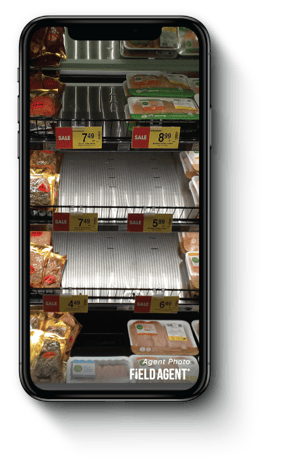
Here are just a few headlines published within 24 hours of writing this article:
- "The meat shortages are here: Costco and Kroger warn of limited supply" (New York Post)
- "Costco, Sam’s, Kroger, Tom Thumb limit meat purchases as processing plants struggle with outbreaks" (Dallas Morning News)
- "Meat shortages are real. Just ask Wendy’s, Costco, and Tyson" (Barron’s)
And it’s frankly all too believable, given that many of us have visited our neighborhood stores in recent days to find some awfully lean meat selections—heavy out-of-stocks on chicken, beef, and pork, for instance.
At Endcaps & Insights, all the pessimistic predictions about U.S. meat supply got us wondering a couple of questions:
- How bad is out there—really?
- How are shoppers responding to meat shortages?
So, we turned to the Field Agent on-demand platform for the full story.
Free Guidebook: 9 Coronavirus Challenges At-Retail...and How to Overcome Them
Audits & Surveys: Exploring the Reported U.S. Meat Shortage
To better understand the two questions above, we conducted both a 102-store audit of meat stock-levels as well as a survey of 1,500 shoppers.
First, on Saturday, May 2, Endcaps & Insights turned to the Field Agent platform to audit six meat categories— fresh chicken, frozen chicken, ground beef, bacon, ham luncheon meat, and pork chops—inside stores across the country. The audit helped us understand the severity of the meat shortage at the shopper-level.
We ultimately distributed the audits across 13 major retailers in relative proportion to the number of U.S. stores operated by each retailer. Endcaps & Insights conducted 24 audits at Walmart, 17 at Kroger, 13 at Albertsons/Safeway, 10 at Aldi, 8 at Food Lion, and 7 at Publix. We also audited fewer than five stores at Whole Foods, Super Target, Giant Food, H-E-B, Hy-Vee, BI-LO, and Winn-Dixie.
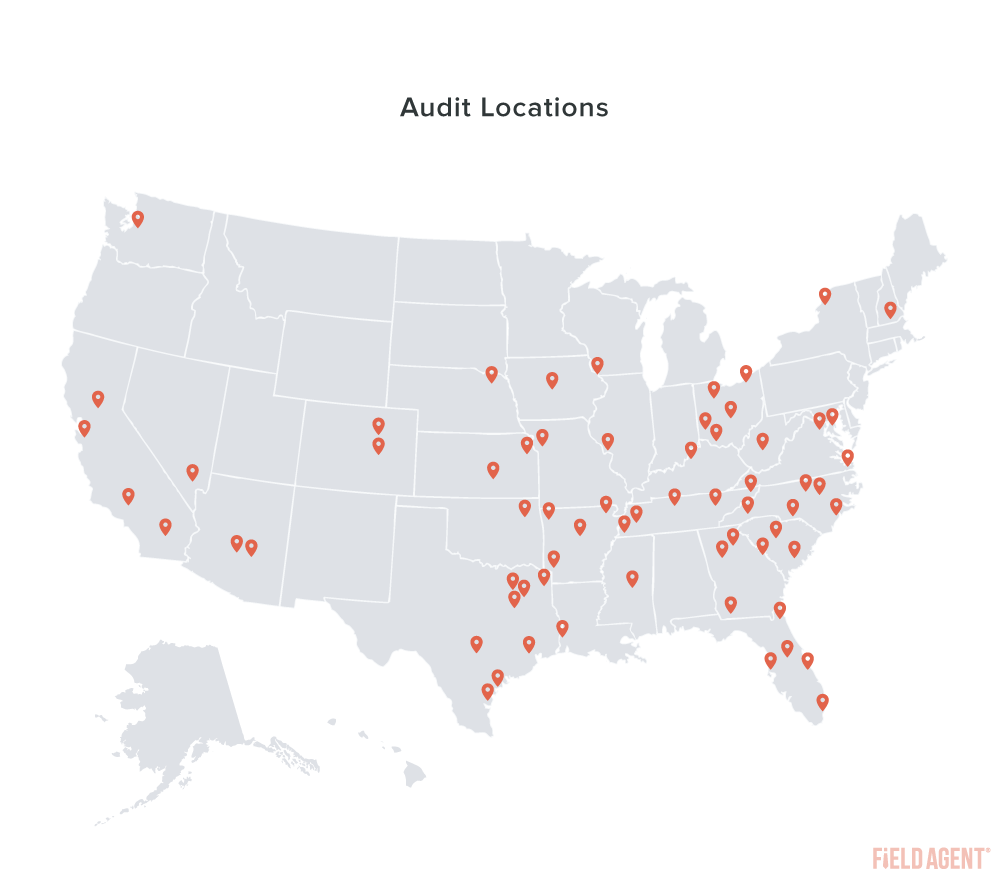
Then, on Monday, May 4, we again used the Field Agent platform, this time to survey 1,500 U.S. adults* to understand, among other things, how their households are responding to the dwindling meat supply.
*All survey respondents were U.S. adults at least 18 years of age and Field Agent app-users. The survey was executed exclusively through the Field Agent platform, May 4, 2020. To make the sample more representative of the general population, Field Agent occasionally weighted data to more accurately reflect the racial composition of the general U.S. population. Demos for the base sample of 1,500: Gender - Female (73%), Male (27%), Age - 18-34 (32%), 35-44 (36%), 45-54 (21%), 55+ (11%); Race - Caucasian (75%), Other (11%), African American (8%), Latino/Hispanic (6%); Household Income - < $35K (24%), $35-49K (18%), $50-74K (23%), $75-99K (16%), $100K+ (19%).
With the results from these two studies as our guide, let’s now examine this timely topic—one that has retailers limiting meat purchases, meat producers issuing warnings, and shoppers nervously stocking up.
Is There a Meat Shortage at the Store-Level?
In the audit, we asked agents to capture photos of meat selections and to report stock-levels inside their designated store.
For each category, agents selected one of the following options:
- Completely/almost completely stocked (91-100% stocked)
- Mostly stocked (61-90% stocked)
- About half stocked/half out-of-stock (41-60% stocked)
- Mostly out-of-stock (11-40% stocked)
- Almost completely out-of-stock (1-10% stocked)
- Completely out-of-stock (0% stocked)
The good news: As of Saturday, agents reported relatively few stores as completely out-of-stock on, really, any category.
The chart below displays the “completely OOS rate” and “almost completely OOS rate” for each category. As you can see, in our audit, chicken—whether frozen (13%) or fresh (9%)—was most likely to be entirely out-of-stock.
The takeaway: On Saturday, most shoppers at most stores could still find at least one brand, size, or, otherwise, variation of these staple meats.
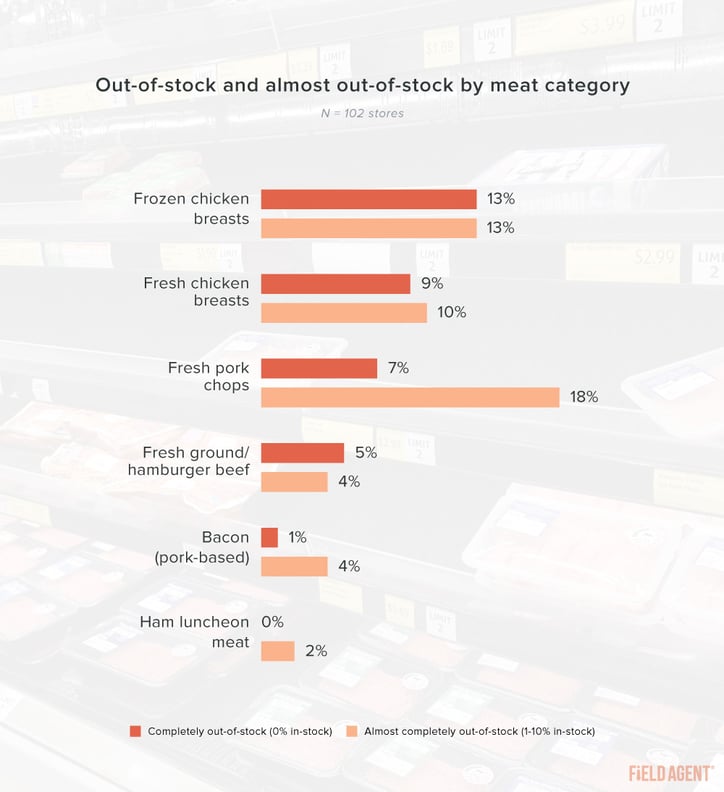
It was also interesting to note the variation in OOS rates across retailers. Consider the combined completely/almost completely OOS rate for frozen chicken (for retailers with 7 or more stores in the audit):
- Publix (n = 7 stores) - 71% completely or almost completely OOS on frozen chicken (completely OOS = 14%)
- Food Lion (n = 8 stores) - 50% (completely OOS = 12%)
- Kroger (n = 17 stores) - 24% (completely OOS = 12%)
- Aldi (n = 10 stores) - 20% (completely OOS = 10%)
- Walmart (n = 24 stores) - 4% (completely OOS = 0%)
Uniquely, of 13 Albertsons/Safeway stores audited, not a single store was completely OOS on frozen chicken, and only one store was almost completely OOS in the category. In fact, notably, Albertsons/Safeway didn't show a single 0% stock-level for any meat category at any store (in the audit).
But, there was also sobering news. In many stores, meat selections looked pretty darn skimpy—offering, perhaps, a foreboding sign of things to come.
Case-in-point: In 57% of audited stores, sections designated for pork chops were reported to be no more than half stocked. It was a similar story for fresh chicken (54%), frozen chicken (49%), and ground beef (49%).
In other words, there are plenty of ominous-looking holes in those refrigerated deli cases.
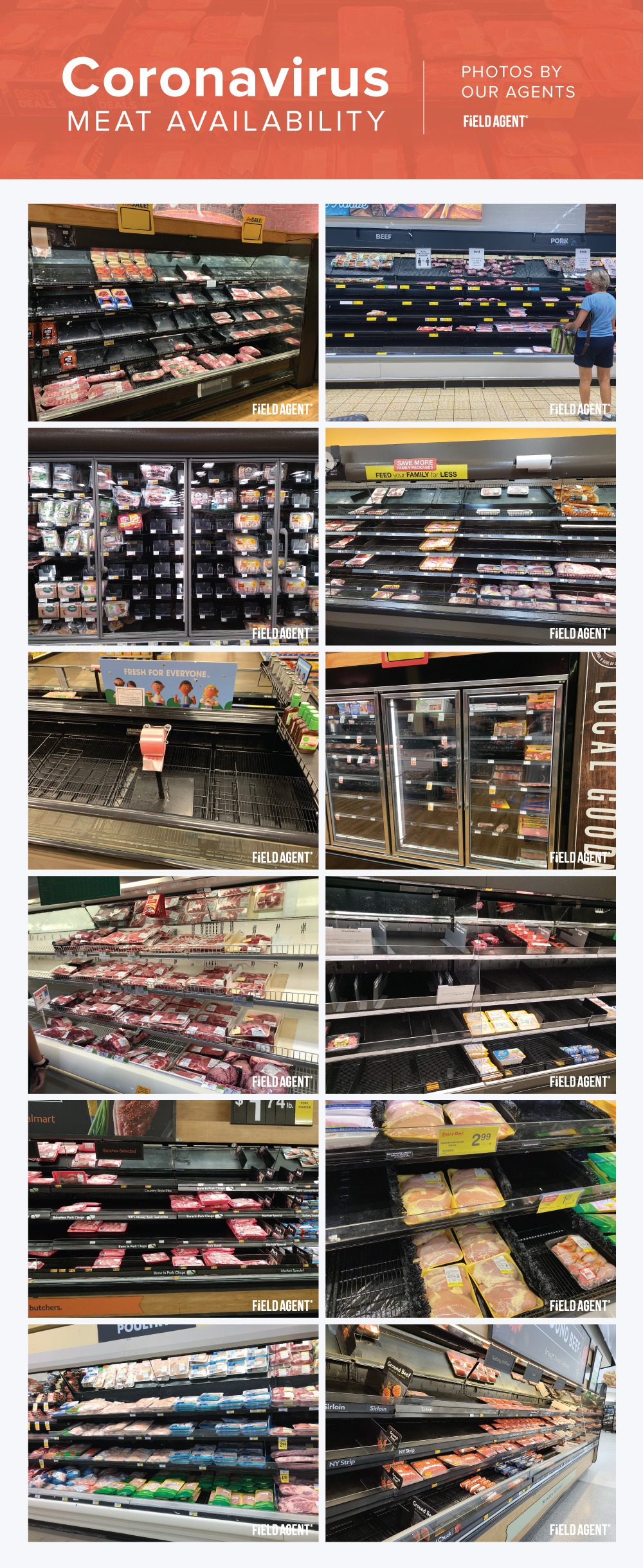
Meat Shoppers & Out-of-Stocks
When seeking to purchase meat, shoppers at large are also having plenty of run-ins with OOSs.
In our survey of 1,500 U.S. adults, including 1,064 individuals who say they’ve shopped for meat in-store or online since the beginning of the pandemic, 82% said they’ve encountered at least one OOS when shopping for meat.
You can see the breakdown in the chart below. Of 873 respondents who have shopped for meat since the outbreak, and who have spotted at least one OOS, 68% reported coming up empty at least once when shopping for ground beef, which made it the most frequently OOS meat category in the survey. Fresh, unfrozen chicken was right behind at 63%.
So, between shopper reports and the results of Saturday’s audit, OOSs are absolutely a store-level reality.
It should be noted: While the audit asked agents to report stock-levels on categories of meat, the survey asked shoppers about OOSs at the SKU-level.
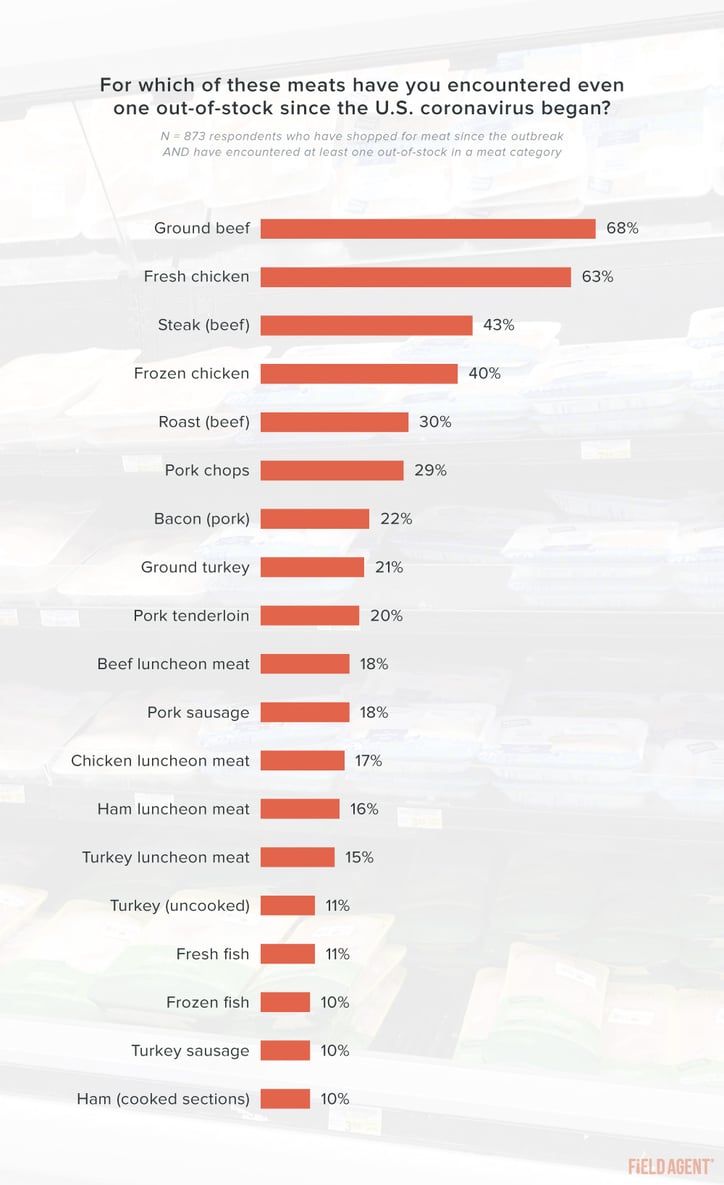
But, what is the perception of the meat supply? Will shoppers say meat stock-levels look about normal (on one extreme), or will they say stock-levels look as bad as they’ve ever seen (on the other extreme)?
We asked.
In all, of 1,064 respondents who have shopped for meat since the pandemic, virtually half (48%) said “meat stock-levels are the worst I’ve ever seen,” while another 35% said “meat stock-levels look worse than normal, [but I’ve seen worse].”
Only 17% reported that meat availability looks “fairly normal to me.”
In the shopper’s mind, then, we’re currently dealing with unprecedented levels of OOSs on popular meat categories.
How are Households Responding to a Meat Shortage?
Now we arrive at a key question. One, potentially, with critical implications for the near future.
When shoppers can’t buy their preferred meat, what do they do?
Prior to the larger survey of 1,500, we asked 100 meat buyers to describe ways their households are responding to shortages/OOSs on meat. Their free form responses became the basis for the choice options presented to respondents in the quantitative survey.
The chart below displays the responses of 881 survey respondents who have shopped for meat since the COVID-19 outbreak and who have witnessed, according to their own reports, heavier-than-usual OOSs on meat.
About half of shoppers surveyed said they stock-up on meat when it is available, and about the same number say they’re resorting to shopping multiple retailers for their meat.
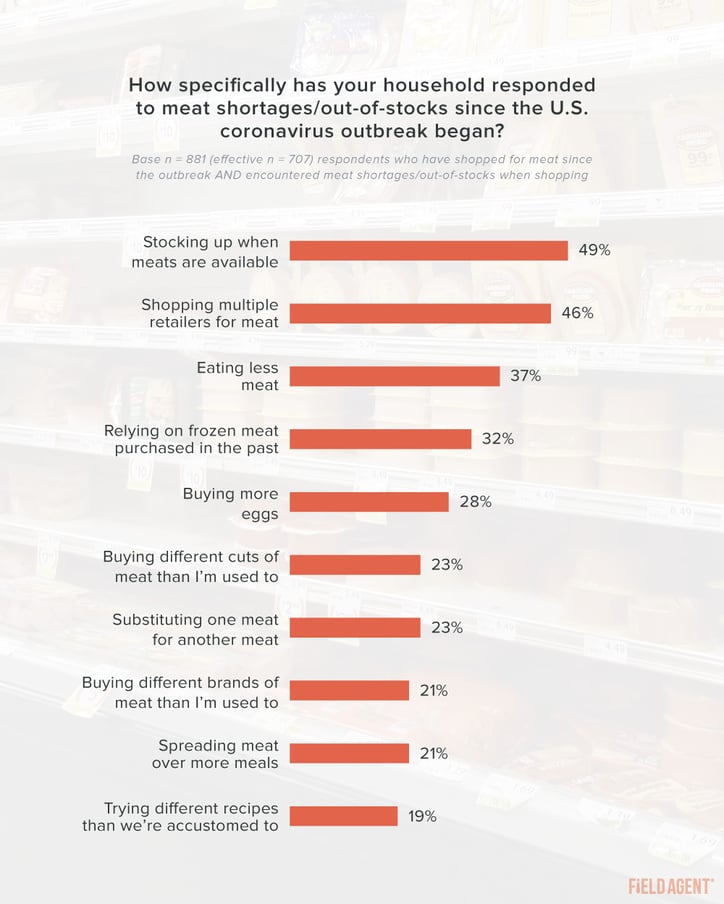
Yet, there are many other tactics shoppers are using in the face of a meat shortage, some of them less obvious. A selection:
- Eating more meatless/vegetarian meals (17%)
- Buying more beans (16%)
- Buying more peanut butter (11%)
- Using local butchers (11%)
- Buy more meat prepared by restaurants (9%)
- Purchasing more meal kits (7%)
- Purchasing meat-less but meat-like substitutes such as Beyond Meat and MorningStar (5%)
With meat producers warning of shortages to come, these “tactics” could become even more pronounced in the following days and weeks.
Wrapping Up: Any Way You Slice It
Between our audit of 102 meat departments and our survey of 1,500 shoppers, it seems OOSs on popular meat categories have become a common feature of shopping in-store and online.
However, results suggest OOSs on meat have not yet become so severe that shoppers have to leave stores/websites completely empty-handed.
Consider: Of six meat categories audited across 102 stores, or 612 category-level inspections, only 6% were found to be completely out-of-stock on Saturday.
Still, enough shoppers (82%) have encountered SKU-level OOSs on meat that households are already finding ways to compensate for a meat shortage. Chief among them are stocking up, shopping multiple retailers, and simply eating less meat.
Yet, any way you slice it, the weeks ahead will be crucial for meat producers, retailers, and, of course, shoppers and their shopping routines.
As important as it is, meat supply is still only one captivating topic to emerge from the pandemic thus far. At Endcaps & Insights, we’re keeping an eye on it all.
From changing diets to online grocery-pickup, Endcaps & Insights is an excellent place to keep tabs on the latest retail developments with COVID-19.
Subscribe to Endcaps & Insights
Endcaps & Insights is where retail headlines come to life through fresh insights, illuminating photos, and curated videos. It's a great way to stay in-the-know about the latest happenings across the retail industry. Subscribe below!

